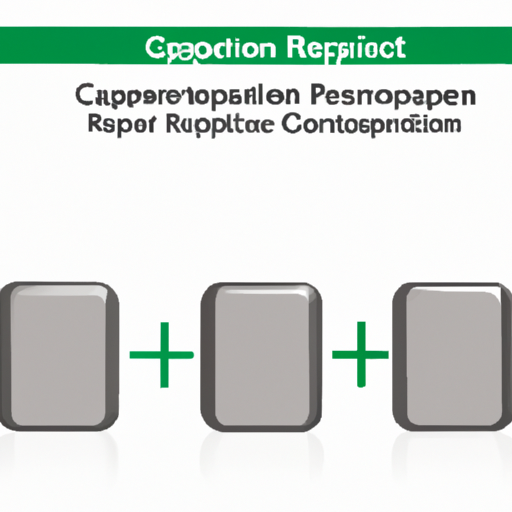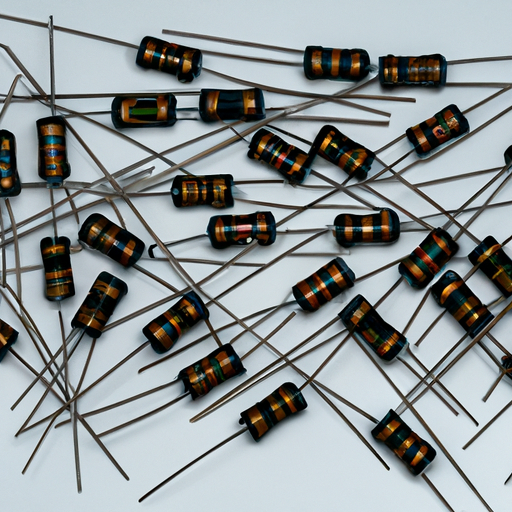CORE_COMPETENCE
Product_Leaders
index_more
index_more_content
info_item01
info_item_content01
info_item02
info_item_content02
info_item03
info_item_content03
info_item04
info_item_content04
NEWS
NEWS
S6008L Resistors highlighting the core functional technology articles and application development cases of Resistors that are effective.
Overview of S6008L Resistors and Their Applications
The S6008L resistors are a specific type of resistor that can be utilized in various electronic applications. While detailed articles and case studies on the S6008L resistors may not be readily available, we can explore the core functional technology of resistors in general and highlight effective application development cases that demonstrate their utility.
Core Functional Technology of Resistors
1. **Basic Functionality**: Resistors are fundamental components in electronic circuits, designed to limit the flow of electric current. They are characterized by their resistance value, measured in ohms (Ω), and are essential for controlling voltage and current levels within a circuit.
2. **Types of Resistors**:
- **Fixed Resistors**: These resistors have a constant resistance value and are widely used in various applications.
- **Variable Resistors**: These include potentiometers and rheostats, which allow for adjustable resistance, making them useful in applications requiring fine-tuning.
- **Specialty Resistors**: This category includes thermistors (temperature-sensitive), photoresistors (light-sensitive), and others that serve specific functions.
3. **Material Composition**: The performance of resistors is influenced by their material composition. Common materials include carbon, metal film, and wire-wound materials, each offering different characteristics in terms of stability, power handling, and temperature coefficient.
4. **Power Rating**: Resistors are rated for the maximum power they can dissipate without overheating. This rating is crucial for ensuring reliability and preventing failure in high-power applications.
5. **Tolerance**: Tolerance indicates the allowable variation from the stated resistance value. Resistors with lower tolerance values are preferred in precision applications where accuracy is critical.
6. **Temperature Coefficient**: This parameter measures how much the resistance changes with temperature, which is vital for applications that require stable performance across varying environmental conditions.
Application Development Cases
1. **Voltage Divider Circuits**: Resistors are often used in voltage divider configurations to create reference voltages. For instance, in sensor applications, the S6008L could be employed to scale down voltages to levels suitable for microcontroller inputs, ensuring accurate readings.
2. **Current Limiting in LED Circuits**: In LED applications, resistors are essential for limiting the current flowing through the LED, preventing damage and ensuring optimal brightness. The S6008L can be effectively used in these circuits to maintain consistent performance.
3. **Signal Conditioning in Audio Applications**: Resistors are integral to audio signal processing, where they work alongside capacitors to filter and shape the frequency response of audio equipment. This is crucial for designing high-fidelity audio systems that deliver clear sound.
4. **Pull-Up and Pull-Down Resistors in Digital Circuits**: In digital electronics, resistors are used to ensure that inputs to logic gates are at defined levels (high or low) when no active devices are driving the inputs. This is essential for reliable operation in microcontroller and FPGA designs, where the S6008L could be utilized.
5. **Temperature Sensing with Thermistors**: Thermistors, a type of resistor, are widely used in temperature sensing applications. They provide accurate temperature readings for HVAC systems, automotive applications, and consumer electronics, showcasing the versatility of resistors in various fields.
6. **Power Supply Regulation**: Resistors play a critical role in power supply circuits, helping to regulate voltage levels and ensure stable operation of electronic devices. They can be part of feedback loops in voltage regulators, contributing to the overall efficiency and reliability of power management systems.
Conclusion
Resistors, including specific types like the S6008L, are vital components in a wide array of electronic applications. Their ability to control current and voltage, along with their diverse forms and materials, makes them indispensable in circuit design. Understanding their core functionalities and applications can lead to more effective and innovative designs in electronics. For specific articles and case studies, consulting technical journals, manufacturer datasheets, and application notes from resistor manufacturers would provide deeper insights into the S6008L and its applications.
2025-04-12
What are the main application directions of variable resistors?
What are the Main Application Directions of Variable Resistors?
I. Introduction
Variable resistors, commonly known as potentiometers, rheostats, or digital potentiometers, are essential components in electrical engineering. They allow for the adjustment of resistance within a circuit, enabling control over various electrical parameters such as voltage, current, and power. The importance of variable resistors cannot be overstated, as they play a crucial role in a wide range of applications, from audio equipment to medical devices. This blog post will explore the main application directions of variable resistors, highlighting their types, advantages, challenges, and future trends.
II. Types of Variable Resistors
A. Potentiometers
**Definition and Functionality**
Potentiometers are three-terminal devices that allow for the adjustment of voltage levels in a circuit. They consist of a resistive element and a wiper that moves along the element, changing the resistance and, consequently, the voltage output.
**Common Applications**
Potentiometers are widely used in audio equipment for volume control, tone adjustment, and balance settings. They are also found in various consumer electronics, such as televisions and radios, where user input is required to adjust settings.
B. Rheostats
**Definition and Functionality**
Rheostats are a type of variable resistor designed to handle higher currents. They typically have two terminals and are used to adjust the current flowing through a circuit.
**Common Applications**
Rheostats are commonly used in applications requiring motor speed control, such as in electric fans and light dimmers. They are also utilized in laboratory settings for controlling heating elements and other devices.
C. Digital Potentiometers
**Definition and Functionality**
Digital potentiometers are electronically controlled variable resistors that use digital signals to adjust resistance. They offer greater precision and can be integrated into microcontroller systems.
**Common Applications**
Digital potentiometers are increasingly used in modern electronics, including audio processing, signal conditioning, and automated systems where precise control is necessary.
III. Main Application Directions of Variable Resistors
A. Audio Equipment
**Volume Control**
In audio systems, variable resistors are primarily used for volume control. By adjusting the resistance, users can increase or decrease the audio signal's amplitude, allowing for a comfortable listening experience.
**Tone Control**
Variable resistors also play a role in tone control, enabling users to adjust bass, midrange, and treble frequencies. This functionality enhances the overall audio experience, allowing for personalized sound profiles.
B. Automotive Applications
**Dashboard Controls**
In vehicles, variable resistors are used in dashboard controls for functions such as adjusting the brightness of instrument panels and controlling climate settings. This enhances user comfort and safety while driving.
**Engine Management Systems**
Variable resistors are integral to engine management systems, where they help regulate fuel injection and ignition timing. This ensures optimal engine performance and fuel efficiency.
C. Industrial Equipment
**Motor Speed Control**
In industrial settings, variable resistors are used to control the speed of electric motors. By adjusting the resistance, operators can fine-tune motor performance for various applications, from conveyor belts to pumps.
**Temperature Control**
Variable resistors are also employed in temperature control systems, such as in ovens and HVAC systems. They allow for precise adjustments to heating elements, ensuring consistent temperature regulation.
D. Consumer Electronics
**Home Appliances**
In home appliances, variable resistors are used in devices like washing machines and microwaves to control settings such as cycle duration and power levels. This enhances user convenience and energy efficiency.
**Gaming Devices**
In gaming consoles and controllers, variable resistors are used for joystick sensitivity and volume control. This allows for a more immersive gaming experience, as players can customize their settings.
E. Medical Devices
**Diagnostic Equipment**
Variable resistors are crucial in medical diagnostic equipment, such as ultrasound machines and ECG monitors. They allow for the adjustment of signal levels, ensuring accurate readings and patient safety.
**Therapeutic Devices**
In therapeutic devices, such as TENS units and infusion pumps, variable resistors help control the intensity and duration of treatments, providing tailored care for patients.
F. Telecommunications
**Signal Processing**
In telecommunications, variable resistors are used in signal processing equipment to adjust signal levels and improve clarity. This is essential for maintaining high-quality communication.
**Network Equipment**
Variable resistors are also found in network equipment, where they help manage power levels and signal integrity, ensuring reliable data transmission.
IV. Advantages of Using Variable Resistors
A. Flexibility in Circuit Design
Variable resistors offer significant flexibility in circuit design, allowing engineers to create adjustable systems that can be tailored to specific applications. This adaptability is crucial in developing innovative technologies.
B. Cost-Effectiveness
Variable resistors are generally cost-effective components, making them accessible for various applications. Their simplicity and reliability contribute to lower production costs in electronic devices.
C. Ease of Use and Integration
Variable resistors are user-friendly and can be easily integrated into existing systems. Their straightforward functionality allows for quick adjustments, enhancing user experience across multiple applications.
V. Challenges and Limitations
A. Wear and Tear
One of the primary challenges associated with variable resistors is wear and tear. Mechanical components, such as potentiometers and rheostats, can degrade over time, leading to reduced performance and reliability.
B. Precision and Accuracy Issues
While variable resistors offer flexibility, they may not always provide the precision required for certain applications. This can be a limitation in high-accuracy environments, such as medical devices and scientific instruments.
C. Alternatives to Variable Resistors
With advancements in technology, alternatives to traditional variable resistors, such as digital signal processors and programmable gain amplifiers, are becoming more prevalent. These alternatives can offer enhanced performance and reliability.
VI. Future Trends in Variable Resistor Technology
A. Advancements in Digital Potentiometers
The future of variable resistors lies in the continued development of digital potentiometers. These devices offer greater precision, programmability, and integration with digital systems, making them ideal for modern applications.
B. Integration with Smart Technologies
As smart technologies become more prevalent, variable resistors will increasingly be integrated into IoT devices and smart home systems. This will enable more sophisticated control and automation in various applications.
C. Sustainable Practices in Manufacturing
The push for sustainability in electronics manufacturing will likely influence the production of variable resistors. Manufacturers may adopt eco-friendly materials and processes to reduce environmental impact.
VII. Conclusion
In conclusion, variable resistors are vital components in electrical engineering, with applications spanning various industries, including audio, automotive, industrial, consumer electronics, medical, and telecommunications. Their flexibility, cost-effectiveness, and ease of use make them indispensable in modern technology. However, challenges such as wear and tear and precision issues must be addressed as technology evolves. The future of variable resistors looks promising, with advancements in digital technology, integration with smart systems, and a focus on sustainability paving the way for innovative applications. As we continue to explore the potential of variable resistors, their role in shaping the future of technology remains significant.
2025-03-14

























